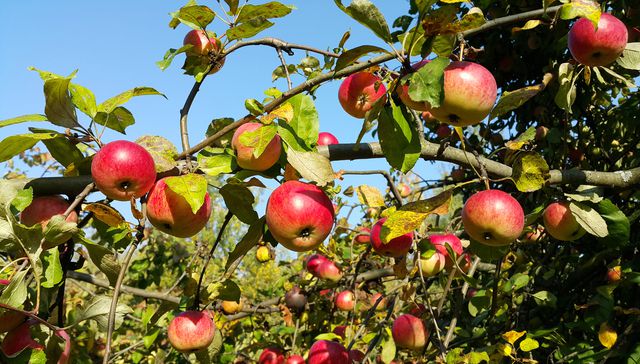You should prune your apple tree regularly so that it bears a lot of fruit. Learn here how to get a bountiful harvest with the right pruning in spring and fall.
Pruning apple trees: Important for tree health
Sure, wild apple trees bear fruit, too. But if you prune your apple tree twice a year – in fall and spring – your harvest will be especially rich. Proper pruning and regular inspections will also keep your tree healthy.
Contents
Pruning apple tree in spring

Spring pruning is the most extensive treatment of the year for your apple tree. It usually takes place between February and March. During this period, the tree is in dormancy and thrives slowly. This allows it to fully prepare for the growth of new shoots.
Pruning your apple tree at this time of year will save your tree, as no young buds have formed yet. In addition, you are specifically stimulating it to form new shoots at the intersections.
Freshly cut wounds are now less susceptible to pests or fungi due to the weather. The wounds can heal more quickly. Pruning in the spring also has the advantage that, thanks to the leafless branches, you can easily see where thinning is needed. Any growths and malformations can be seen particularly well now.
Tip: If the temperature is still below minus five degrees, it is better to wait for milder days before pruning. The wood is too brittle below this level and your tree could be damaged during pruning.
Pruning apple tree in autumn
If your apple tree is healthy and well cared for, it will delight you with delicious fruit in the fall. But the weeks from the beginning of October are not only harvest time. Now you should check and prune your apple tree.
In autumn, you should especially prune branches that have grown inwards and are too thin. This will ensure that the stronger shoots have enough space and light for their new shoots in spring. If your apple tree bears a lot of fruit, it can happen that individual branches break under their load and die. You should also remove these now.
Also look for fruit mummies when inspecting in the fall. The underdeveloped, dead fruit can linger quite unnoticed on your tree over the summer. Search it carefully now. At this point, at the latest, all fruit mummies must be removed. Otherwise, they could become an ideal breeding ground for harmful fungi.
Rule of thumb for pruning apple trees

When pruning your apple tree, you can simply use the yield from the previous year as a guide: If your apple tree has borne few fruits, you can prune generously. This will help your tree to produce strong new shoots and increase the coming harvest. If you were satisfied with the harvest, prune only what is necessary.
Pruning apple tree: The right technique
Your apple tree, like most fruit trees, bears its fruit only on two-year-old branches. So be sure not to prune back healthy one-year-old shoots. This would prevent the production of new fruit stems. Young shoots are easily recognized by their lighter color.
When pruning vertically growing branches, be careful not to make the cuts horizontally. Fungus may form on the stumps from standing rainwater. Always use sharp plant shears (e.g. online at **Avocadostore)and make sure the cuts are smooth. Larger cut surfaces from three centimeters in diameter, you can coat with organic wound wax (eg at ** Amazon). Fungicides contained in it prevent fungal spores and other pathogens.
Last but not least: Be considerate of the tree’s inhabitants

With all the love for your tree, please always think about its small inhabitants. Between March and September, you should refrain from pruning your apple tree out of consideration for nesting birds. If you still want to remove individual branches during this time, please proceed carefully and keep an eye out for bird nests.









